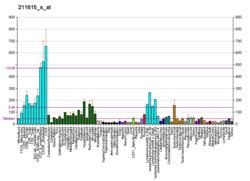LRPPRC
 From Wikipedia the free encyclopedia
From Wikipedia the free encyclopedia
| LRPPRC | |||||||||||||||||||||||||||||||||||||||||||||||||||
|---|---|---|---|---|---|---|---|---|---|---|---|---|---|---|---|---|---|---|---|---|---|---|---|---|---|---|---|---|---|---|---|---|---|---|---|---|---|---|---|---|---|---|---|---|---|---|---|---|---|---|---|
| Identifiers | |||||||||||||||||||||||||||||||||||||||||||||||||||
| Aliases | LRPPRC, CLONE-23970, GP130, LRP130, LSFC, leucine rich pentatricopeptide repeat containing, MC4DN5 | ||||||||||||||||||||||||||||||||||||||||||||||||||
| External IDs | OMIM: 607544; MGI: 1919666; HomoloGene: 32695; GeneCards: LRPPRC; OMA:LRPPRC - orthologs | ||||||||||||||||||||||||||||||||||||||||||||||||||
| |||||||||||||||||||||||||||||||||||||||||||||||||||
| |||||||||||||||||||||||||||||||||||||||||||||||||||
| |||||||||||||||||||||||||||||||||||||||||||||||||||
| |||||||||||||||||||||||||||||||||||||||||||||||||||
| |||||||||||||||||||||||||||||||||||||||||||||||||||
| Wikidata | |||||||||||||||||||||||||||||||||||||||||||||||||||
| |||||||||||||||||||||||||||||||||||||||||||||||||||
Leucine-rich PPR motif-containing protein, mitochondrial is a protein that in humans is encoded by the LRPPRC gene.[5][6][7] Transcripts ranging in size from 4.8 to 7.0 kb which result from alternative polyadenylation have been reported for this gene.[7]
Function
[edit]This gene encodes a protein that is leucine-rich and is thought to play a role in regulating the interaction of the cytoskeleton with a variety of cellular processes.[8]
Clinical significance
[edit]An integrative genomics strategy led to the discovery that mutations in LRPPRC cause the French-Canadian variant of Leigh syndrome.[9] Furthermore, mutation in the LRPPRC gene causes lowered expression of MT-CO1 (cytochrome c oxidase I) and MT-CO3.[10]
References
[edit]- ^ a b c GRCh38: Ensembl release 89: ENSG00000138095 – Ensembl, May 2017
- ^ a b c GRCm38: Ensembl release 89: ENSMUSG00000024120 – Ensembl, May 2017
- ^ "Human PubMed Reference:". National Center for Biotechnology Information, U.S. National Library of Medicine.
- ^ "Mouse PubMed Reference:". National Center for Biotechnology Information, U.S. National Library of Medicine.
- ^ Hou J, Wang F, McKeehan WL (Jul 1994). "Molecular cloning and expression of the gene for a major leucine-rich protein from human hepatoblastoma cells (HepG2)". In Vitro Cell Dev Biol Anim. 30A (2): 111–4. doi:10.1007/BF02631402. PMID 8012652. S2CID 24824618.
- ^ Andersson B, Wentland MA, Ricafrente JY, Liu W, Gibbs RA (Jun 1996). "A "double adaptor" method for improved shotgun library construction". Anal Biochem. 236 (1): 107–13. doi:10.1006/abio.1996.0138. PMID 8619474.
- ^ a b "Entrez Gene: LRPPRC leucine-rich PPR-motif containing".
- ^ Liu L, McKeehan WL (January 2002). "Sequence Analysis of LRPPRC and Its SEC1 Domain Interaction Partners Suggests Roles in Cytoskeletal Organization, Vesicular Trafficking, Nucleocytosolic Shuttling and Chromosome Activity". Genomics. 79 (1): 124–36. doi:10.1006/geno.2001.6679. PMC 3241999. PMID 11827465.
- ^ Mootha VK, Lepage P, Miller K, Bunkenborg J, Reich M, Hjerrild M, Delmonte T, Villeneuve A, Sladek R, Xu F, Mitchell GA, Morin C, Mann M, Hudson TJ, Robinson B, Rioux JD, Lander ES (January 2003). "Identification of a gene causing human cytochrome c oxidase deficiency by integrative genomics". Proc. Natl. Acad. Sci. U.S.A. 100 (2): 605–10. doi:10.1073/pnas.242716699. PMC 141043. PMID 12529507.
- ^ Xu F, Morin C, Mitchell G, Ackerley C, Robinson BH (August 2004). "The role of the LRPPRC (leucine-rich pentatricopeptide repeat cassette) gene in cytochrome oxidase assembly: mutation causes lowered levels of COX (cytochrome c oxidase) I and COX III mRNA". Biochem. J. 382 (Pt 1): 331–6. doi:10.1042/BJ20040469. PMC 1133946. PMID 15139850.
Further reading
[edit]- Yu W, Andersson B, Worley KC, et al. (1997). "Large-Scale Concatenation cDNA Sequencing". Genome Res. 7 (4): 353–8. doi:10.1101/gr.7.4.353. PMC 139146. PMID 9110174.
- Kuroda H, Sugimoto T, Horii Y, Sawada T (2001). "Signaling pathway of ciliary neurotrophic factor in neuroblastoma cell lines". Med. Pediatr. Oncol. 36 (1): 118–21. doi:10.1002/1096-911X(20010101)36:1<118::AID-MPO1028>3.0.CO;2-R. PMID 11464862.
- Liu L, McKeehan WL (2002). "Sequence Analysis of LRPPRC and Its SEC1 Domain Interaction Partners Suggests Roles in Cytoskeletal Organization, Vesicular Trafficking, Nucleocytosolic Shuttling and Chromosome Activity". Genomics. 79 (1): 124–36. doi:10.1006/geno.2001.6679. PMC 3241999. PMID 11827465.
- Strausberg RL, Feingold EA, Grouse LH, et al. (2003). "Generation and initial analysis of more than 15,000 full-length human and mouse cDNA sequences". Proc. Natl. Acad. Sci. U.S.A. 99 (26): 16899–903. Bibcode:2002PNAS...9916899M. doi:10.1073/pnas.242603899. PMC 139241. PMID 12477932.
- Mootha VK, Lepage P, Miller K, et al. (2003). "Identification of a gene causing human cytochrome c oxidase deficiency by integrative genomics". Proc. Natl. Acad. Sci. U.S.A. 100 (2): 605–10. doi:10.1073/pnas.242716699. PMC 141043. PMID 12529507.
- Liu L, Amy V, Liu G, McKeehan WL (2003). "Novel Complex Integrating Mitochondria and the Microtubular Cytoskeleton with Chromosome Remodeling and Tumor Suppressor Rassf1 Deduced by in Silico Homology Analysis, Interaction Cloning in Yeast, and Colocalization in Cultured Cells". In Vitro Cell. Dev. Biol. Anim. 38 (10): 582–94. doi:10.1290/1543-706X(2002)38<582:NCIMAT>2.0.CO;2. PMC 3225227. PMID 12762840.
- Mili S, Piñol-Roma S (2003). "LRP130, a Pentatricopeptide Motif Protein with a Noncanonical RNA-Binding Domain, Is Bound In Vivo to Mitochondrial and Nuclear RNAs". Mol. Cell. Biol. 23 (14): 4972–82. doi:10.1128/MCB.23.14.4972-4982.2003. PMC 162214. PMID 12832482.
- Bouwmeester T, Bauch A, Ruffner H, et al. (2004). "A physical and functional map of the human TNF-alpha/NF-kappa B signal transduction pathway". Nat. Cell Biol. 6 (2): 97–105. doi:10.1038/ncb1086. PMID 14743216. S2CID 11683986.
- Labialle S, Dayan G, Gayet L, et al. (2004). "New invMED1 element cis-activates human multidrug-related MDR1 and MVP genes, involving the LRP130 protein". Nucleic Acids Res. 32 (13): 3864–76. doi:10.1093/nar/gkh722. PMC 506807. PMID 15272088.
- Liu L, Vo A, Liu G, McKeehan WL (2005). "Putative tumor suppressor RASSF1 interactive protein and cell death inducer C19ORF5 is a DNA binding protein". Biochem. Biophys. Res. Commun. 332 (3): 670–6. doi:10.1016/j.bbrc.2005.05.006. PMC 3225229. PMID 15907802.
- Cooper MP, Qu L, Rohas LM, et al. (2006). "Defects in energy homeostasis in Leigh syndrome French Canadian variant through PGC-1α/LRP130 complex". Genes Dev. 20 (21): 2996–3009. doi:10.1101/gad.1483906. PMC 1620022. PMID 17050673.
- Ewing RM, Chu P, Elisma F, et al. (2007). "Large-scale mapping of human protein–protein interactions by mass spectrometry". Mol. Syst. Biol. 3 (1): 89. doi:10.1038/msb4100134. PMC 1847948. PMID 17353931.
External links
[edit]- LRPPRC human gene location in the UCSC Genome Browser.
- LRPPRC human gene details in the UCSC Genome Browser.
This article incorporates text from the United States National Library of Medicine, which is in the public domain.





